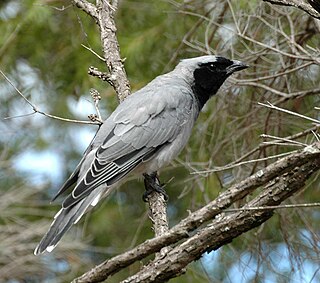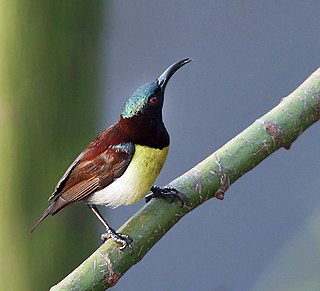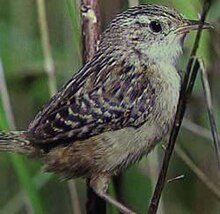
Wrens are a family of brown passerine birds in the predominantly New World family Troglodytidae. The family includes 88 species divided into 19 genera. Only the Eurasian wren occurs in the Old World, where, in Anglophone regions, it is commonly known simply as the "wren", as it is the originator of the name. The name wren has been applied to other, unrelated birds, particularly the New Zealand wrens (Acanthisittidae) and the Australian wrens (Maluridae).

Urocissa is a genus of birds in the Corvidae, a family that contains the crows, jays, and magpies.

The marsh wren is a small North American songbird of the wren family. It is sometimes called the long-billed marsh wren to distinguish it from the sedge wren, also known as the short-billed marsh wren.

The sedge wren is a small and secretive passerine bird in the family Troglodytidae. It is widely distributed in North America. It is often found in wet grasslands and meadows where it nests in the tall grasses and sedges and feeds on insects. The sedge wren was formerly considered as conspecific with the non-migratory grass wren of central and South America.

The grass wren is a species of passerine bird in the family Troglodytidae. It is widely distributed in central and southern America.

Haplospiza is a small genus of birds in the tanager family Thraupidae. Formerly classified in the bunting and American sparrow family Emberizidae, more recent studies have shown it to belong in the Thraupidae. Its two members breed in subtropical or tropical moist forest in Central and South America. They are often associated with bamboo.

Hemithraupis is a small genus of passerine birds in the tanager family Thraupidae found in the forests of South America.

Coryphospingus is a small genus of finch-like tanagers found in South America. Coryphospingus was formerly classified in the family Emberizidae along with the buntings and American sparrows.

The black-goggled tanager is a species of bird in the family, Thraupidae. It is the only member of the genus Trichothraupis. It is found at low levels in forest and woodland in a large part of eastern and southern Brazil, eastern Paraguay and far north-eastern Argentina, with a disjunct population along the East Andean slope in Peru, Bolivia and far north-western Argentina. While generally common and widespread, and consequently considered to be of least concern by BirdLife International and IUCN, the population associated with the Andes is relatively local and uncommon.

Tachycineta is a genus of birds in the swallow family Hirundinidae. There are nine described species all restricted to the Americas.

The yellow penduline tit is a species of bird in the family Remizidae. This small yellow passerine bird is found in semi-arid savanna regions of West Africa.

Apolinar's wren is a passerine bird in the family Troglodytidae. It is endemic to Colombia.

Coracina is a large genus of birds in the cuckooshrike family Campephagidae.

Percnostola is a genus of insectivorous passerine birds in the family Thamnophilidae.

Terenura is a genus of insectivorous passerine birds in the antbird family, Thamnophilidae.

Leptocoma is a genus of sunbirds found from tropical South Asia to Papua New Guinea. Its members are sometimes included in Nectarinia.

Stagonopleura is a genus of small seed-eating birds in the family Estrildidae that are native to Australia.

Pogonotriccus is a genus of small passerine birds in the family Tyrannidae. They are found in wooded habitats of Central and South America.

Pheugopedius is a genus of wrens in the family Troglodytidae that are found in Central and South America.

Poodytes is a genus of passerine birds in the grassbird family Locustellidae.




















